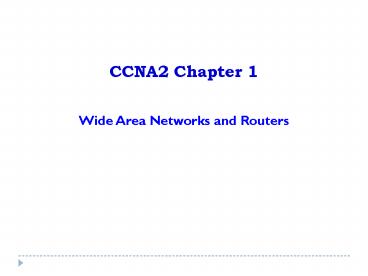CCNA2 Chapter 1 - PowerPoint PPT Presentation
1 / 23
Title:
CCNA2 Chapter 1
Description:
WAN is a data communications network that operates beyond a LAN's ... the equipment from CPE/DTE from aberrant voltages, and to square' up the signal. ... – PowerPoint PPT presentation
Number of Views:2285
Avg rating:5.0/5.0
Title: CCNA2 Chapter 1
1
CCNA2 Chapter 1
- Wide Area Networks and Routers
2
WAN Wide Area Networks
- WAN is a data communications network that
operates beyond a LANs geographic scope. - Users subscribe to a WAN provider such as ATT,
Sprint, etc. These providers offer network
services such as - Frame Relay
- Integrated Services Digital Network (ISDN)
- Asynchronous Transfer Mode (ATM)
- These services carry different traffic types
voice, data and video. - WANs operate at the first three layers of the
OSI. (Frame Relay actually operates at layer 1
and layer 2.) All of the WAN services have layer
1 layer 2 in common. - Other characteristics of WAN are
- operate past LAN geographic area
- use serial connections
- provide full-time part-time connectivity
3
Router Internal Components
- Main internal components of the router
- Random-access memory (RAM)
- Nonvolatile random-access memory (NVRAM)
- Flash memory
- Read-only memory (ROM)
- Interfaces
4
Router Internal Components
- RAM
- stores routing tables
- holds ARP cache
- holds fast-switching cache
- performs packet buffering
- maintains packet-hold queues
- provides temporary memory for the configuration
file of the router while the router is powered on - loses content when router is powered down or
restarted
5
Router Internal Components
- NVRAM
- provides storage for the startup configuration
file - retains content when router is powered down or
restarted
6
Router Internal Components
- Flash memory
- holds the operating system image (IOS)
- allows software to be updated without removing
replacing chips on the processor - retains content when router is powered down or
restarted - can store multiple versions of IOS software
- is electronically erasable, programmable ROM
(EEPROM)
7
Router Internal Components
- ROM
- maintains instructions for power-on self test
(POST) diagnostics - stores bootstrap program basic operating
system software - requires replacing pluggable chips on the
motherboard for software upgrades
8
Router Internal Components
- Interfaces
- connect router to network for frame entry and
exit - can be on the motherboard or on a separate
module - connect the router to LANs and WANs
9
Router Internal Components
RAM is used for routing table information and it
holds the running configuration.
The interfaces provide LAN and WAN connectivity.
NVRAM is used to store the backup/startup
configuration file.
The console port provides physical access for
initial configuration.
Flash memory is used for storage of full Cisco
IOS software images.
ROM is used for permanently storing startup
diagnostic code.
10
Subscriber to Provider Interface
Modem
Router
DCE
DTE
Example interface between the Data Terminal
Equipment (DTE) such as a router to the Data
Circuit-Terminating equipment (DCE) to the WAN
network such as a modem. DTE is on the customers
side of the network. - converts user information
into signals for transmission, or reconverts the
received signals into user information The DCE -
is typically a modem and in many cases is
circuitry in a CO, switch which is made up of a
CSU/DSU (Channel Service Unit/Data Service Unit).
The major reason for CSU/DSU is to protect the
equipment from CPE/DTE from aberrant voltages,
and to square up the signal. DCE is usually on
the providers side. - A device that establishes,
maintains and terminates a session on a network.
It may also convert signals for transmission. It
11
Sample Lab Setup
12
Subscriber to Provider Interface
EIA/TIA-232, V.35, X.21, HSSI, others
Modem
Router
DCE
DTE
13
Router Physical Characteristics
- The 3 basic types of connections on a router are
- LAN interfaces
- WAN interfaces
- Management ports
- Console
- auxiliary
14
(No Transcript)
15
Router Physical Characteristics
- Management ports provide
- Text-based connection
- Configuration, monitoring, password recovery and
troubleshooting
- The management ports
- EIA-232 asynchronous serial ports
- used for non-network connections
- used for initial router configuration
- to connect to a port, a PC must have a terminal
emulation program - rollover cable from PC to the management ports
16
Management Ports
- The console port, says Cisco is preferred when
troubleshooting - doesnt depend on network services
- displays start and error messages by default
- To establish a connection between PC and a
router, one needs - terminal emulation software
- rollover cable
- RJ-45 to DB-9 connector
17
(No Transcript)
18
Router Physical Characteristics
- Cisco says, the terminal emulation software,
HyperTerminal, the parameters used to configure a
router are - Data bits
- Stop bits
- parity
19
Routers connection LAN and WAN
- For a PC of a LAN to connect to a router, one
- straight-thru cable from the PC to a HUB or
switch - straight-thru cable from the HUB or switch to
routers Ethernet interface
20
Routers connection LAN and WAN
- An internetwork must include
- switching
- dynamic or static routing
- consistent end-to-end addressing
21
Routers connection LAN and WAN
EIA/TIA-232, V.35, X.21, HSSI, others
Modem
Router
DCE
DTE
- The connections to WAN on router is through the
serial interface, either as a Smart Serial
interface connector or DB-60 connector. - The following devices are used in the
construction of a WAN - communication servers
- routers
- modems
22
Router vs. PC
- According to Cisco, the common components between
a router and PC are - CPU
- input/output interfaces
- system bus
23
(No Transcript)































